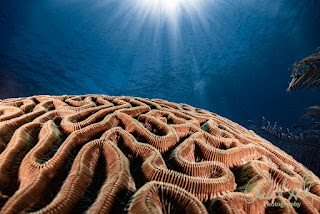Understanding Shooting Modes on your Camera
What – Why – When – Where
Again, this week, I was asked by an Underwater Photographer hobbyist/enthusiast,
to spend a little time and help them figure out why their photos were not coming
out of the camera, like what they had shot underwater.
Camera manufacturers have made it easier for photographers
to take photographs. However, the multitude of features can be overwhelming,
and only a few are utilized. The abundance of shooting modes is a case in
point.
After conversing with numerous photographers, I have
realized that many do not comprehend how different shooting modes function, and
more importantly, when, where, and why they should select a specific mode.
Many photographers report an affinity for aperture priority.
I wonder why. It certainly has its place. But if I look at their work and many
of the images were created with a wide-angle lens, aperture priority should be
the least of their concerns.
When shooting with wide lenses, aperture priority is less of
a concern. The wide-angle lens provides a high level of apparent sharpness,
even if the photograph is created with the largest aperture.
All DSLR cameras offer four shooting modes: manual, aperture
priority, shutter priority, and program.
Some cameras offer 'full auto' and 'scene modes' (portrait, sports, landscape, macro, underwater, and night), as well as custom settings and video options. Your camera's shooting mode dial may offer additional options such as custom settings and video recording.
- I advise against using the ‘scene modes’ for your photographs if photography means something to you. The use of ‘scene modes’ removes the thought process.
Photographers often face difficulty setting up their
camera's ISO or adjusting the flash output. When I have helped them, I usually find
that they have mistakenly set their camera to 'AUTO' shooting mode.
Manufacturers often use a variety of acronyms and terms to
describe shooting modes, which can lead to confusion among users.
Let’s discuss some of the basic modes and what they are and do.
- With the Auto Mode option on your camera, most of the settings will be taken care of automatically. All you need to do is focus and press the shutter button. On some newer cameras, there is even a 'smile detector' that automatically takes the photo when it detects a smile, leaving no need for you to press the button.
- My recommendation- NEVER set your camera to the full AUTO-shooting mode.
- A great alternative to the AUTO Mode is the PROGRAM Mode – In this mode, you get to choose the ISO, color balance, flash settings, and exposure compensation. The Camera will decide the shutter speed and aperture (f-stop) combination and that is all.
- The downside to Program Mode is that the camera is looking for average settings, so it picks a shutter speed of 1/250th of a second and an aperture of f/8.0. If your subject is moving or it is in a very dark location, this might not work for you.
- The next primary mode is the Shutter Priority (‘S’ or ‘Tv’). Using this mode, the camera will take the shutter speed that you have chosen and then adjust the aperture and ISO based on the metering mode you have selected.
- Aperture Priority – This mode is one of the most widely used modes by professional photographers. You set the aperture which affects the depth of field and amount of light that enters the camera, and the shutter speed and ISO will be adjusted automatically by the camera based again on the metering mode used by the user.
- Manual Mode – This is used almost as widely by professional photographers as Aperture Priority. This is my preferred mode for underwater photography because it allows the user to control all aspects of the camera and strobes.
- Every photographer will select their preferred mode to use based on their style, and niche that they have developed.
Above I have discussed the major modes of cameras, but as I
have said all but the Manual Mode adjusts either shutter speeds, aperture, or
ISO, based on the Metering Mode. So, what is the Metering Mode?
· The Metering Mode determines how much
light is entering the camera. It helps the camera determine where the intensity
of the light is located.
I
will discuss the various Metering Modes in next week’s Blog.
I am eagerly anticipating your valuable feedback and suggestions.
Sincerely,
Bob Herb




Comments
Post a Comment
Please let me know your comments.